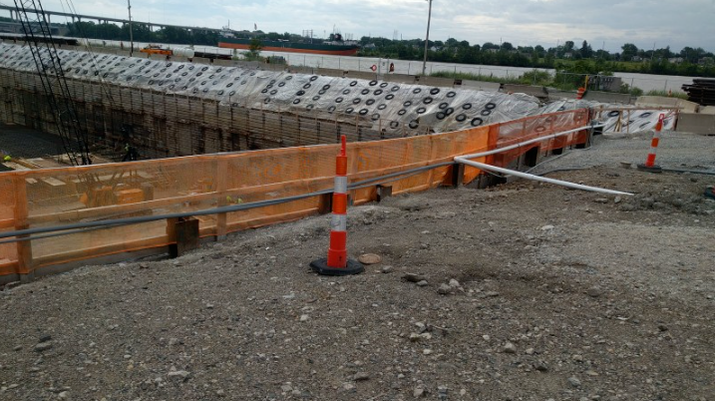Civil Geotechnical Engineering Services for Commercial and Residential Projects
Wiki Article
How Consulting Engineers Enhance Geotechnical Design Projects: Insights Into Their Knowledge, Methodologies, and Collaborative Approaches
Consulting designers are crucial in enhancing geotechnical design jobs, applying their specialized knowledge to browse the complexities of subsurface conditions. Their collective strategies foster interaction amongst varied task stakeholders, ultimately forming the task's trajectory.Role of Consulting Engineers
The expertise of seeking advice from engineers in geotechnical design is fundamental to the effective implementation of construction jobs. These experts play an essential role in analyzing soil and rock residential or commercial properties, which are vital aspects affecting layout and building and construction choices. By carrying out detailed website examinations, consulting engineers collect crucial data that informs the design procedure, making certain tasks are improved stable and suitable ground.Consulting engineers also provide invaluable insights right into danger administration (geotechnical geologist). They determine potential geotechnical threats, such as landslides, soil liquefaction, and settlement concerns, allowing stakeholders to apply efficient reduction methods. Their expertise aids in optimizing structure styles, which can bring about considerable expense financial savings and boosted security
Moreover, getting in touch with designers work as a vital web link between project proprietors, designers, and specialists. Their capability to translate complicated geotechnical data right into actionable referrals promotes partnership and facilitates notified decision-making throughout the project lifecycle. This multidisciplinary strategy not only boosts job performance but additionally guarantees conformity with regulative criteria and finest techniques.
Key Methods in Geotechnical Engineering

One primary methodology is site investigation, which involves performing field tests and laboratory evaluations to collect information on subsurface problems. Strategies such as Standard Penetration Testing (SPT) and Cone Penetration Testing (CPT) are widely used to examine dirt stratigraphy and strength. Additionally, geophysical methods, including seismic and electrical resistivity surveys, provide non-invasive means to evaluate subsurface qualities.
One more essential technique is numerical modeling, which makes it possible for designers to imitate numerous circumstances and forecast exactly how soil-structure interactions will behave under different loading problems. Limited Aspect Analysis (FEA) is an usual method utilized in this context.
In addition, the layout of foundations, maintaining structures, and earthworks relies greatly on these methods - geotechnical geologist. By integrating advanced logical devices with field information, consulting designers can establish tailored solutions that attend to particular project obstacles, eventually contributing to the security and security of building tasks
Value of Soil Evaluation
Dirt analysis works as a foundational aspect in geotechnical engineering, supplying important understandings into the physical and chemical properties of soil essential for effective building planning. Recognizing soil characteristics is essential for identifying its load-bearing capacity, water drainage behavior, and capacity for negotiation or instability. In-depth dirt investigations, consisting of tasting and lab testing, help determine specifications such as dirt type, wetness material, density, and shear toughness.
These analyses notify the choice of ideal construction methods and products, eventually affecting task safety and longevity. For instance, cohesive dirts might need different structure layouts contrasted to granular dirts, demanding customized engineering solutions. Moreover, dirt evaluation aids in determining pollutants that might present dangers to human health and wellness or the atmosphere, enabling for the development of mitigation strategies.
Including dirt evaluation into the beginning of project growth aids to lessen unpredicted obstacles, making sure that designers can prepare for and resolve possible issues prior to they escalate. By establishing an extensive understanding of the site conditions, consulting designers can enhance design performance and minimize costs, therefore improving the overall success of geotechnical design jobs.
Joint Techniques in Projects
Effective geotechnical projects frequently rest on collective methods that bring with each other diverse competence from various techniques. Effective cooperation amongst speaking with designers, geologists, ecological scientists, and construction specialists is vital for attending to complex obstacles and enhancing project results. By leveraging the distinct skills and expertise of each staff member, tasks can gain from an all natural understanding of the site problems, regulative requirements, and design restrictions.Regular interaction and interdisciplinary meetings promote the sharing of understandings and cultivate a culture of team effort. These joint efforts enable the identification of prospective threats early in the project lifecycle, enabling for prompt reduction strategies. Moreover, integrating responses from stakeholders, consisting of local neighborhoods and regulative firms, makes certain that all perspectives are thought about, improving task approval and compliance.
Additionally, the assimilation of innovative modern technologies, such as Geographic Details Solution (GIS) and Structure Info Modeling (BIM), further improves cooperation. These tools enable the real-time sharing of data and visualization of geotechnical problems, promoting informed decision-making. Ultimately, a joint method not only simplifies job implementation yet likewise lays the foundation for ingenious services to complex geotechnical engineering obstacles.
Effect On Project End Results

Consulting designers use sophisticated methodologies such as danger analysis and predictive modeling, which boost the accuracy of job projections. Their capacity to integrate cutting-edge technologies, like geotechnical instrumentation and data analytics, better refines the design and building and construction processes. As an outcome, projects experience improved efficiency, minimized prices, and lessened delays.
Additionally, cultivating effective interaction and collaboration amongst team members boosts analytical capacities. When difficulties arise, a joined front enables for quick recognition of services, protecting against possible obstacles. Eventually, civil geotechnical engineering the collaborative efforts of getting in touch with designers contribute to greater high quality outcomes, making sure that jobs meet both governing standards and customer assumptions.
Final Thought

Report this wiki page